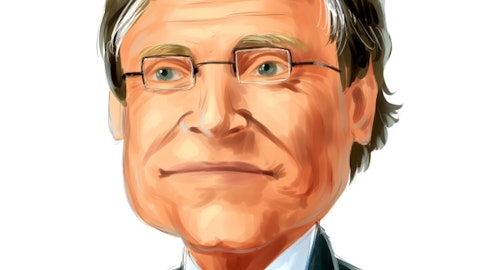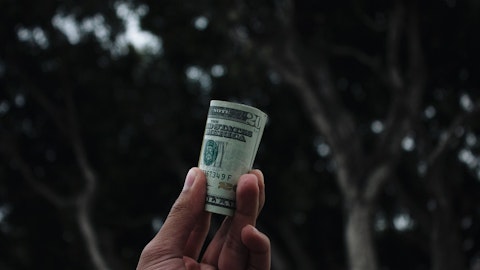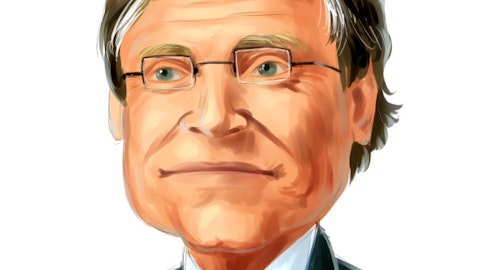But that being said, it’s very early in the process. So, it’s going to leverage as well or lead to better results in the quarters to come. It’s still a lot of work that remains, but I like the progression. It’s going to be always better, so as we move forward. Now the last point on the onetime sale was related to a contractual commitment that we had to deliver by the end of the third quarter. If you strip that out, Healthcare had kind of low single type of growth, which is better than in the past, but probably what we’re going to see in the next immediate quarters until we can truly accelerate by leveraging the power of the Institution. But overall, I like the progress that we’re making in Healthcare, but let me be very clear. So, I’ve not been happy with the performance of Healthcare for many years.
I’m really happy with what the team is doing now in terms of transformation, early results, more is to come and more work is also required to get to the place that we all want to be with that business.
Operator: Our next question is from the line of David Begleiter with Deutsche Bank.
David Begleiter: Thank you and very nice quarter, Christophe and team. Just on the delivered product costs, they came in below your expectations — or better than your expectations. What drove that? And what are your expectations for Q4?
Christophe Beck: So, DPC or delivered product cost was roughly 3% down versus last year. A little bit better than what we had expected. It’s always a very broad mixed bag, as you know. So we have 10,000 raw materials that we buy. So they didn’t all go in the same direction, obviously. So some easing on the market. At the same time, our supply chain team speak, procurement team did also some remarkable work as well with our partner suppliers. So both together led to this 3% easing versus last year. Keeping in mind that our costs are still 40% higher than where they used to be pre-inflation. That’s important to keep in mind. I expect kind of the same type of costs for Q4, so kind of a similar easing versus the prior year.
And I expect basically those costs to stay similar in the quarters to come, which will mean the slight easing versus ‘23 when we talk about ‘24. I’m not banking on big improvements in the quarters to come. And if they come, well, we will all benefit from them.
Operator: Next question is from the line of Jeff Zekauskas with JPMorgan.
Jeff Zekauskas: Ecolab buys its raw materials sometimes monthly, sometimes quarterly, sometimes annually. So, raw materials have moved down through the course of the year, but it may be that the timing of your contractual agreements has slowed the benefits for Ecolab. Can you talk about how you purchase your raw materials in terms of the way raw materials are repriced? That is, should we expect different incremental changes on a six-month basis or a three-month basis or an annual basis?
Christophe Beck: Well, I have two ways to answer your questions, in a complicated way or in a simple way, Jeff. So, I’ll go for the simple way. You’re right that depending on the raw materials, it’s monthly, some quarterly, some annually with different types of contractual agreements. I think, we have a very good team. We have a new leadership as well who is doing an exceptional work, by the way, so on procurement. The short way to explain it is, usually, we have a two- or three-quarter lag between the market-to-market price changes up or down, by the way, that impact two or three quarters down the road our P&L. That’s the rule of thumb that I’m using and that you should be using as well.
Operator: Our next question is from the line of John McNulty with BMO Capital Markets.
John McNulty: So the Industrial business, I guess I was a little surprised to not see a little bit better margin lift just given that you have gotten some good pricing there and the raw materials does look like are starting to come off. So I guess, one, can you help us to think about what the volumes were there? And then, do you feel like we’re at a bottom in terms of the volumes for that business, and maybe we start to see things level off a bit? Or is there more to kind of think about in terms of concerns going forward? How would you frame that?
Christophe Beck: Thank you, John. Well, Industrial is in a very good place, actually. But I’d like to ask Scott maybe to give some perspective on margins evolution.
Scott Kirkland: Yes, happy to, Christophe. So yes, as you’re referring to the Industrial wide growth was at 8% but the growth rates are really impacted by a couple of things. Certainly, there’s a base comparison to last year. If you look at this on a two-year basis, that business is improving. And then also, as we spoke to on the SG&A, they’re impacted by the incentive comp given the strong performance they’ve had in the year. But overall, in that business, as Christophe sort of referenced, that the strong pricing that we delivered this year, we continue to add new pricing. And now as we start to see that DPC easing modestly, and there was certainly the biggest impact by that. But on a dollar basis, that OI really remains very strong and I think will continue to improve off these levels.
But really, as Christophe mentioned, the opening, expect that the growth to return to double-digit OI growth in the fourth quarter, and you’ll see the marginal impact on that as well.
Christophe Beck: Yes. As mentioned early on, John, I like a lot the performance of Industrial for the past few years, and that’s going to be even more true in the years to come. If you strip out that incentive-based compensation, so the OI growth would be in the upper teens, which is what you’re going to see in the fourth quarter as well. So, it was kind of a one-quarter story underlying our performance very strong.
Operator: Our next question comes from the line of Manav Patnaik with Barclays.
Manav Patnaik: Just two-parter, Christophe. So in the pricing, firstly, I think in terms of what you already have in place, if you rolled through, I think you get mid-single-digit pricing next year. But just curious on how you feel like you could keep pushing the pricing dynamic? And then, just a quick follow-up was the new sales pipeline that you’re really confident on, like how big is that the perspective? Like how much of a volume headwind can that offset?





